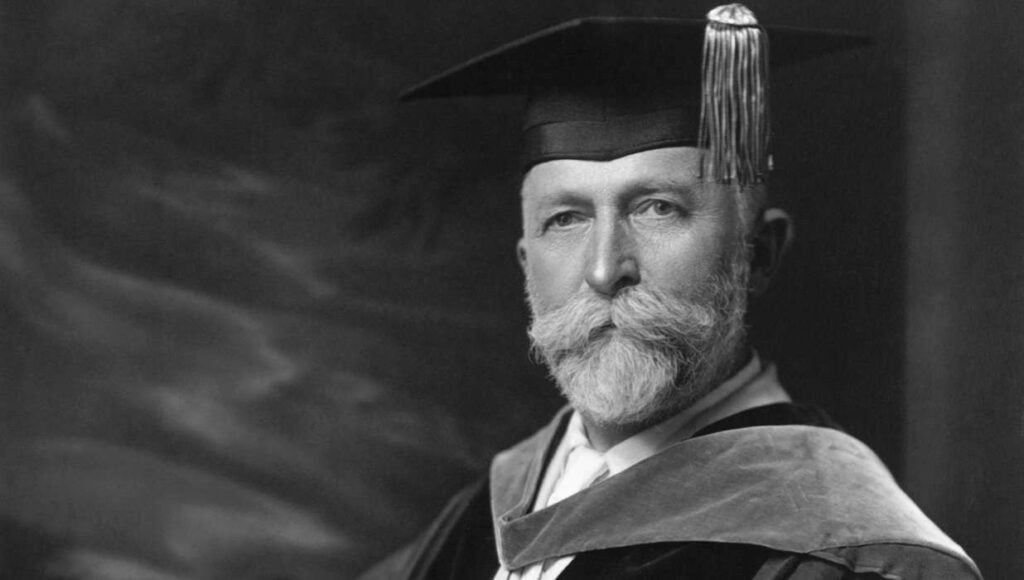The Kellogg brothers helped change the landscape of American nutrition, paving the way for the American standard of breakfast, which is cereals. This was despite their animosity towards one another.
According to Dr. John Kellogg, most illnesses were caused by filthy bowels full of toxins from undigested food. To that purpose, he used a system that could pump fifteen gallons of water into a patient’s colon in seconds to deliver enemas.
Who is Dr. John Harvey Kellogg?
John Harvey Kellogg was born on February 26, 1852, to farmers John Preston and Ann Janette. Kellogg’s large family were Seventh-Day Adventists originally from Livingston County and later in Battle Creek, Michigan. Kellogg was the fourth of eight children. (Source: Biography)
When he was twelve, Kellogg apprenticed in the Adventist publishing house and later developed an interest in health and hygiene. His interest sparked when the church’s prophetess started publishing health articles, and healthy living was a religious duty of all Seventh-Day Adventists.
The church later chose Kellogg to be part of a five-month course with Dr. Russell Trall, as Kellogg was recognized to be a promising individual. This course opened his eyes to the world of medicine and health reform. He soon took up formal medical education and graduated in 1875. (Source: OOCities)
Kellogg soon became the editor of Adventist monthly publication Health Reformer, which he continued to do so for the rest of his life. Kellogg has also published more than fifty books. All focused on health and well-being. He was also credited for creating the Battle Creek Sanitarium (known as the San), which attracted powerful and influential individuals of their time.
Kellogg married Ella Eaton in 1879 and fostered forty-two children, adopting seven of them. Kellogg believed that sex bred evil diseases so much he maintained celibacy throughout his life.
Kellogg is credited for many achievements in his life, including the formation of the American Medical Missionary College in Chicago, and of course, the famous cornflake.
Kellogg continued his work in his old age and finally succumbed to pneumonia on December 14, 1942, at 91. (Source: OOCities)
What Else Did Dr. Kellogg Contribute?
Kellogg created many new foods in his quest to create a perfect diet. In 1877, he invented Granola, a crumbled multigrain biscuit. Dr. James Caleb, who had previously marketed a similar product, Granula, sued him and forced him to change the name. Kellogg also created peanut butter, meat substitutes, and grain-based coffee. Insufficient chewing caused indigestion and tooth decay, so he invented breakfast cereal. (Source: Biography)
He started having his patients chew a piece of zwieback, a hard German twice-baked bread, before every meal. The two baches broke a patient’s tooth, so Kellogg set out to fix it. He needed a chewable dry, crisp grain product. In 1894, Kellogg invented wheat flakes with Will Keith’s younger brother, The San’s business administrator. After forgetting about a batch of boiled wheat for days, the brothers ran it through rollers and scraped flakes off. They discovered that baked wheat flakes were delicious.
The San guests quickly discovered that the wheat flakes were even better with milk than Kellogg intended. Initially known as Granose, the product later became Toasted Wheat Flakes, and Kellogg sold over 100,000 pounds of it in its first year.
The brothers later flaked corn and rice. However, Kelloggs was not the first to market dry cereal. Henry D. Perky of Denver, Colorado, invented the Shredded Wheat machine in 1893. Following the success of Toasted Wheat Flakes, many imitators flooded the market. Like former San patient Charles W. Post, some succeeded in creating products that competed for the cereal market.
Autointoxication
Kellogg’s obsession with the bowel and the wellness of the human body led him to many medical procedures and prescriptions that were once standard in the field. A fascinating approach Kellogg came up with was flushing the bowel with an enema, therefore cleansing it. (Source: Museum of Quackery)
According to Kellogg, autointoxication was a severe problem for Americans during that time. Autointoxication occurs when one’s toxins are poisoning itself. He believes this happens because the American diet consisted of meat, potatoes, and other heavily fibrous foods.
Kellogg’s solution was to pump patients with water with an enema machine similar to what he witnessed when he studied in Germany. The enema machine was capable of running 15 gallons of water into a bowel in seconds. Every water enema was followed by a pint of yogurt, half-eaten and half enemaed, “thereby planting protective germs where they are most needed and most effective.” The yogurt replaced the bowel’s “intestinal flora,” Kellogg claimed, leaving it “squeaky clean.”
The outcome, Kellogg claimed, was a medical revolution. Kellogg claimed that injecting yogurt cultures into the rectums of wealthy Americans cured “stomach cancer, ulcers, diabetes, schizophrenia, manic depression, acne, anemia, asthenia, migraine, and premature old age.” Nothing a clean bowel couldn’t do. (Source: Museum of Quackery)
Profits from cereal and book sales made Kellogg wealthy, and he funded the elaborate 20-room home where the Kelloggs lived. As his wealth and fame grew, Kellogg’s problems with his brother Will and Adventist leader Ellen White grew. (Source: Biography)
